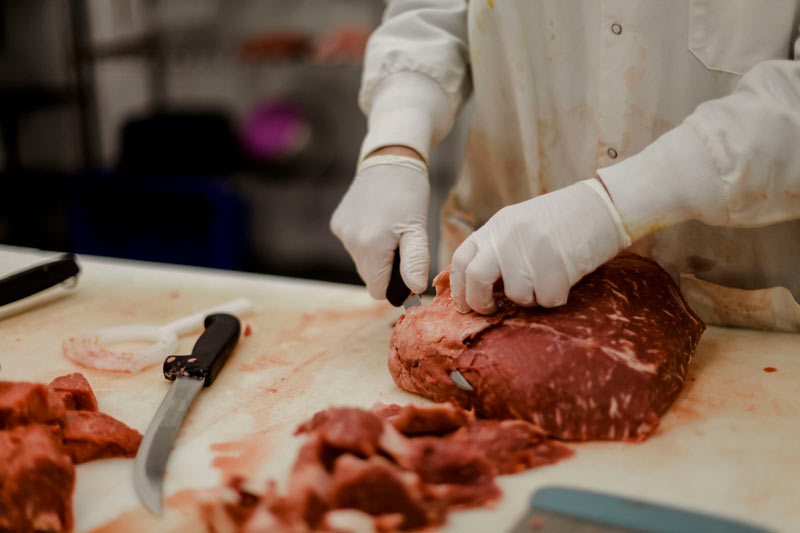Explore the Neighborhood Flavor at Bagley Farms Meat Market Edwardsville IL: Fresh and Delicious
Explore the Neighborhood Flavor at Bagley Farms Meat Market Edwardsville IL: Fresh and Delicious
Blog Article
Uncover the Art of the Butcher's Cut in a Modern Meat Market
In the ever-evolving landscape of contemporary meat markets, the butcher's cut has actually transcended its standard origins, merging old-time workmanship with contemporary practices. What truly establishes the modern-day butcher apart is their ability to build a deeper link between consumers and the beginnings of their meat.
Development of Butchery Methods
The advancement of butchery techniques shows a rich tapestry of development and adaptation driven by improvements in technology, adjustments in consumer demand, and a deeper understanding of meat scientific research. Historically, butchery was a craft passed down through generations, with methods refined over centuries to optimize yield and taste. The industrial revolution ushered in mechanization, changing conventional techniques and allowing massive handling.
The mid-20th century saw butchery methods even more refined by clinical understandings right into muscle mass biology and meat aging, boosting both inflammation and preference. Innovations like vacuum packaging and refrigeration prolonged item shelf-life, allowing butchers to diversify offerings and improve quality assurance. This period also noted the surge of customized equipment, such as band saws and meat slicers, which boosted accuracy and performance in meat handling.

Computerized systems now assist in tracking pet provenance and optimizing cuts to meet particular customer preferences. In addition, a resurgence in artisanal butchery has arised, blending traditional skills with modern knowledge to provide to consumers seeking moral and sustainable meat alternatives.
Understanding Meat Cuts
Recognizing the details of meat cuts is necessary for both butchers and consumers seeking top quality and value. For butchers, specific cuts mirror skill and regard for the craft, ensuring very little waste and optimal yield.

Understanding muscular tissue composition is important; muscle mass utilized much more frequently by the pet often tend to be harder and are best fit for slow-moving food preparation methods, while less-used muscular tissues, like those discovered in the loin, are much more tender and suitable for cooking or roasting. Knowledge with these differences empowers consumers to make enlightened choices, enhancing their culinary undertakings.
Picking High Quality Meat
Choosing the best meat entails greater than just picking an aesthetically appealing item from the screen. bagley farms meat market edwardsville il. The art of selecting quality meat calls for a critical eye and expertise of details attributes that symbolize quality and excellence. Pay attention to the color; beef should have a brilliant, cherry-red color, while lamb ought to show a soft pink tone, and pork a pale pink. This shows the meat is fresh and hasn't been revealed to oxygen for too long.
Secondly, consider the marbling, which describes the white streaks of fat within the muscular tissue. Correct marbling is an essential sign of inflammation and taste, as it thaws during food preparation, enhancing the meat's juiciness. Bear in mind, higher marbling often correlates with superior quality cuts, such as USDA Prime.
Structure is one more important aspect; meat why not try this out must really feel strong to the touch, not slimy or excessively soft. Furthermore, bear in mind the aroma. Fresh meat should have a tidy, neutral smell, totally free from any type of sour or off-putting smells.
Coupling Cuts With Cooking Methods

Alternatively, tougher cuts like brisket and chuck roast are rich in collagen, which breaks down right into jelly when cooked gradually. These cuts are optimal for braising or sluggish roasting, permitting the meat to soften gradually and establish deep, complex tastes. Cuts such as short ribs and pork shoulder make out well with slow-cooking methods, where prolonged cooking times change their robust structures into succulent recipes.
Lamb shanks and oxtail, which call for long term food preparation to tenderize, are excellent candidates for stewing or slow simmering. These techniques coax out rich, hearty flavors while keeping wetness. By recognizing the unique attributes of each cut, chefs and home cooks alike can boost their culinary creations, ensuring each why not check here meal is both pleasing and remarkable.
The Butcher's Function Today
Navigating the developing landscape of the modern-day meat market, the butcher's role today expands beyond mere prep work of cuts. Contemporary butchers are culinary artisans, teachers, and advocates for sustainable techniques. They bridge the space between the ranch and the fork by guaranteeing ethical sourcing, recognizing animal husbandry, and prioritizing openness in the supply find more info chain. This shift shows the expanding customer need for top quality over amount, where provenance and pet welfare are vital.
Along with crafting precise cuts, butchers currently engage straight with customers, supplying cooking suggestions and tailoring options to fit specific requirements and preferences. Their proficiency in meat aging, marbling, and taste accounts equips consumers to make informed decisions, enhancing their cooking experiences. This tailored service exhibits the butcher's progressing duty as a trusted expert in the cooking area.
Additionally, butchers are critical in reducing waste, making use of whole animals to develop varied products such as sausages and supplies. This detailed approach not just appreciates the pet but likewise straightens with contemporary sustainability goals. In this way, the contemporary butcher personifies both practice and innovation, adjusting to an ever-changing market while preserving the creativity and integrity of their craft.
Verdict
Mastery in comprehending diverse meat cuts and high quality signs encourages butchers to give enlightened suggestions, straightening certain cuts with optimal cooking methods. By recognizing historic practices while embracing modern needs, the butcher's duty stays important in today's innovative meat market.
Report this page